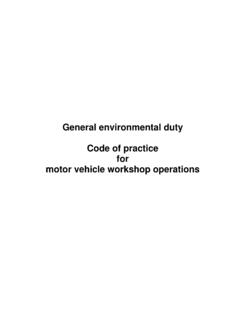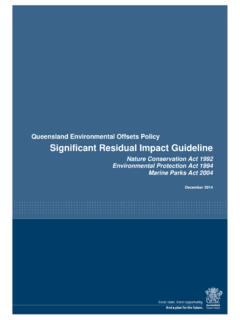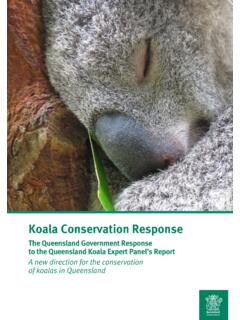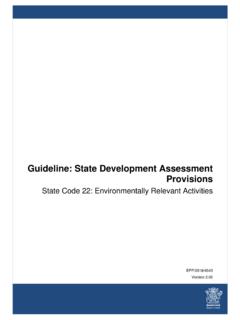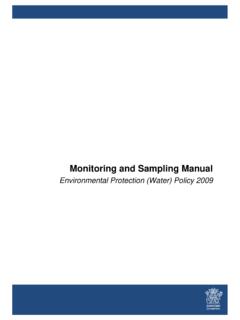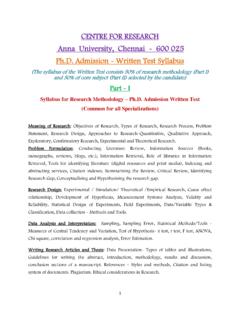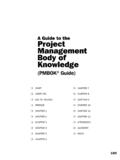Transcription of ESR/2016/1933 Manual for assessing consequence categories ...
1 Manual Page 2 of 31 ESR/2016/1933 Version Effective: 29 MAR 16 Environmental Protection Act 1994 Manual for assessing consequence categories and hydraulic performance of structures This Manual for assessing hazard consequence and hydraulic performance of structures (the Manual ) sets out the requirements of the administering authority, for consequence category assessment and certification of the design of regulated structures , constructed as part of environmentally relevant activities (ERAs) under the Environmental Protection Act 1994 (EP Act). Table of Contents 1 Scope .. 3 Related Guideline and laws .. 3 Background .. 3 Purpose .. 4 2 Assessment requirements .. 4 Initial consequence category assessment .. 4 Exemptions .. 5 consequence category based on assessment of failure event scenarios .. 6 Hydraulic performance criteria for dams that are regulated structures .. 10 Failure to contain seepage.
2 10 Managing seepage consequences for higher risk contaminant 11 Hydraulic performance criteria for regulated dams that are assessed as significant or high consequence for the overtopping scenario .. 12 Hydraulic performance objectives for failure to contain overtopping .. 12 Managing design storage allowance and extreme storm storage in integrated water management systems .. 13 estimating the design storage allowance .. 14 Failure to contain dam break .. 14 Hydraulic performance objectives for failure to contain dam break .. 14 Specific considerations for levees and associated hydraulic performance criteria.. 15 consequence assessment for levees .. 15 Hydraulic performance criteria for levees that are regulated structures .. 16 3 Definitions .. 18 4 References .. 18 Appendix A Example methods for estimating the design storage allowance .. 19 estimating the design storage allowance using the method of deciles for volumetric containment.
3 19 Background .. 19 Method of calculation .. 21 estimating the design storage allowance using the method of operational simulation for performance based containment .. 22 Manual Manual for assessing consequence categories and hydraulic performance of structures Page 2 of 34 ESR/2016/1933 Version Effective: 29 MAR 16 Department of Environment and Science General .. 22 Documentation .. 22 Model continuity and net balance check .. 23 Climate data used in modelling .. 24 Hydrological processes and water management operations .. 24 Conservative assumption of no seepage losses or transmission losses .. 24 Runoff 25 Model calibration and validation .. 25 Accounting for model inaccuracy and lack of calibration data .. 25 Appendix B Notes on consequence assessment based on failure event scenarios .. 27 Flooding considerations for consequence assessment .. 27 Failure to contain consequence .. 27 Dam break flood consequence .. 28 Fundamental consequence evaluation data.
4 28 Inspection of site or desktop 28 Collation and assessment of data .. 29 Appendix C Minimum requirements of certification/certification report .. 30 Version history Version Effective date Description of changes 6 December 2013 Review of Manual and guideline to address operational implementation issues. 13 December 2013 Amendment to Table1. consequence Category Assessment and footnotes. 10 April 2014 Amendment to Table1. consequence Category Assessment, plus other minor grammatical amendments. 29 March 2016 Amendments to exemptions, definition of regulated structure, levees and Table 2. Publication number change from EM635 to ESR/2016/1933 29 March 2016 The document template, header and footer have been updated to reflect current Queensland Government corporate identity requirements and comply with the Policy Register. 29 March 2016 Amendment to references to the Environmental Protection (Water and Wetland Biodiversity) Policy 2019.
5 Manual Manual for assessing consequence categories and hydraulic performance of structures Page 3 of 34 ESR/2016/1933 Version Effective: 29 MAR 16 Department of Environment and Science 1 Scope This Manual for assessing hazard consequence and hydraulic performance of structures (the Manual ) sets out the requirements of the administering authority, for consequence category assessment and certification of the design of regulated structures , constructed as part of environmentally relevant activities (ERAs) under the Environmental Protection Act 1994 (EP Act). The term regulated structures includes land-based containment structures, levees, bunds and voids, but not a tank or container designed and constructed to an Australian Standard that deals with strength and structural integrity. Structures may be assessed using this Manual as being in one of three consequence categories : low, significant or high. Where categorised as a significant or high consequence , the structure is referred to as a regulated structure.
6 This Manual does not provide a detailed methodology for the design of dams, spillways and levee structures. The detailed design of a regulated structure is to be undertaken by a suitably qualified and experienced person1 with relevant professional experience, and requires appropriate documentation and certification2. Related Guideline and laws This Manual relates to, and should be read in conjunction with, the guideline Structures which are dams or levees constructed as part of environmentally relevant activities (ESR/2016/19343) published by the administering authority, The Manual does not limit, amend or change in any way, any other requirements to be complied with under environmental authority (EA) conditions and/or regulations for the design and operation of a dam4. Further, this Manual does not negate any lawful requirements of the EP Act, other Commonwealth, state or local government laws or requirements under relevant standards or agreements.
7 Background Good practice engineering for dams, spillways, and levee structures requires that they be assessed for the consequences associated with dam break and failure to contain scenarios, and that the impacts of such potential failures are identified and considered in their design and operation. The early identification of the consequence potential of these structures is important in determining the standard of reliability required for design, construction and operation of the structure. The default objective for any structure containing substances (liquid and/or solid material) that could result in environmental harm is that the substances be contained so as to prevent or otherwise minimise harm to the environment. Whilst this Manual details the hydraulic performance criteria for regulated structures, it does not prescribe site planning standards. Site planning should consider avoiding wherever possible and practicable locating regulated structures in high risk or sensitive locations ( flood plains, above shallow groundwater systems, residential areas, environmentally sensitive areas).
8 1 The term suitably qualified and experienced person is defined in the definitions. 2 A copy of the certification required can be found at appendix B 3 This is the publication number, which can be used as a search term to find the latest version of the publication at 4 An example of other legislative requirements that may be relevant are those relating to referrable dams under the Water Supply (Safety and Reliability) Act 2008. Manual Manual for assessing consequence categories and hydraulic performance of structures Page 4 of 34 ESR/2016/1933 Version Effective: 29 MAR 16 Department of Environment and Science The Manual does not detail operational standards for regulated structures. However, the water management strategy for a site must entail active management (including if relevant, treatment) of contaminated waters in regulated structures so that in the event of an incident, the impact is reduced to as great an extent as possible, (if not avoided altogether).
9 This should include use of pumps and transfer systems of appropriate capacity to effectively manage contaminant water levels in the structure. Water management should also minimise unnecessary generation of contaminated waters by segregating clean catchment flows from contaminated catchment flows. In this context, regulated structures also include flood protection levees to reduce risk of ingress of clean floodwaters into operational areas where they may become contaminated with possible adverse impact on water management operations and containment performance. Structures that could have significant or high impacts need to be carefully designed and operated. Purpose The purpose of this Manual is to: 1. guide the assessment of the consequence category of all structures constructed as part of activities that require an EA or development approval 2. guide the determination of the structures that require formal documentation; and 3. provide approved methods for specifying the design performance and monitoring requirements for those structures.
10 This document is structured in three parts: Part 1 outlines the requirements for consequence assessment Part 2 outlines the hydraulic performance requirements for dams that are assessed as being regulated structures Part 3 outlines specific considerations for assessing levees and hydraulic performance requirements for levees that are assessed as regulated structures 2 Assessment requirements Initial consequence category assessment This part provides guidance for undertaking a consequence category assessment for a structure which is a dam or levee. All structures which are dams or levees associated with the operation of an ERA, must, unless otherwise stated in this Manual , have their consequence category assessed based on the potential environmental harm that would result from the failure event scenarios (Section ) described in this Manual . Specific considerations for levees are included in part 3 of this Manual and consequence category assessments for levees should be conducted in consideration of the information contained in this section.
